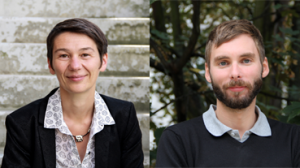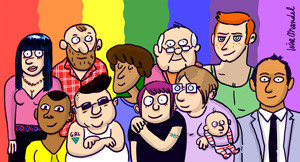Christelle Hamel et Mathieu Trachman
tell us about the INED study of LGBT ways of life, health and situations of insecurity

INED researchers Christelle and Mathieu are specialized in gender and sexuality questions; they are supervising the study on LGBT lifestyles, health and safety.
(Interview conducted in November 2015)
What’s the focus of this survey?
INED is conducting a quantitative survey this year with 27,000 respondents—men and women aged 20 to 69—on the lifestyles, health, and safety situations of the general population in France. To increase lesbian, gay, bisexual and transgender (LGBT) participation and so supplement the information collected on the general population, we’ve set up a specific questionnaire. LGBT people who consult specialized websites (associations, dating and information sites), attend LGBT events or go to LGBT meeting places are invited to fill out the survey.
Who can participate?
All LGBT persons 18 or over. (Minors cannot be questioned for legal reasons.) We want all situations to be represented—men having sexual relations with men, women having sexual relations with women, anyone who defines themselves as lesbian, gay, bisexual and/or transgender—so that the study will encompass LGBT diversity. To ensure the quantity, variety and quality of the results, we need everyone to participate.
Can you tell us something about the LGBT questionnaire?
There are several parts to it. One set of questions is on lifestyles: How do LGBT people live? What are their conjugal and occupational trajectories? What kind of relations do they have with their families and co-workers? This is an important component, because LGBT surveys often focus primarily on sexual health or discrimination, leaving aside more everyday aspects of LGBT persons’ lives.
But the survey also focuses on particular LGBT health issues and experiences of LGBT-phobia. For example, the questionnaire asks for the age that respondent became aware of being attracted to people of the same sex; age(s) they came out to family, friends, co-workers; the negative and/or positive reactions this elicited. In the section for transgender people, transsexual respondents are asked to indicate aspects of transitioning; the questionnaire thus brings to light some of the specific experiences involved.
It also requests information on the types of violence LGBT persons experience, actions create situations of insecurity and vulnerability. While the debates in France around the “marriage for all” legislation did bring about progress in LGBT legal rights, they also led to a rise in LGBT-phobia. These phobia often amount to more or less explicit “calls to order” that perpetuate an image of LGBT people as abnormal. Though annual SOS Homophobie reports give us an idea of the scale of this violence in France, there are no French statistical data based on a representative sample of the general population on this question. The INED study is designed to provide this missing information.
How does a person go about answering the questionnaire?
There’s a specific site with information on the survey and access to the questionnaire. The study is being supported and followed by a considerable number of LGBT websites and associations—it wouldn’t be possible without their support.
Answering the questionnaire takes about 40 minutes. That may seem a bit long, but it’s essential if we want to collect exact information and ensure scientific quality. Respondents don’t have to fill out the questionnaire at one sitting; they can use a passport to retrieve their incomplete questionnaire. And the password also guarantees response anonymity.

